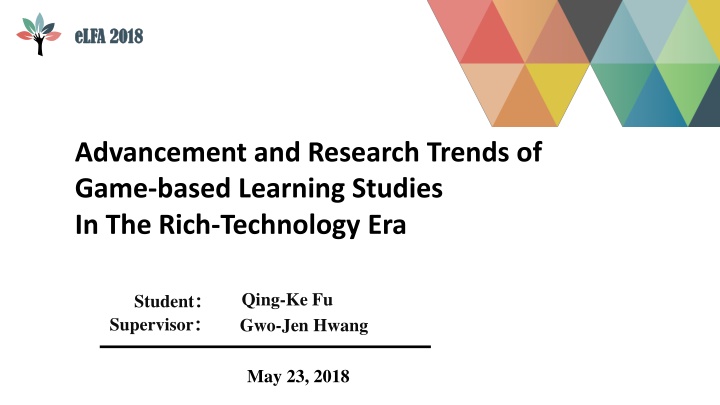
Advancements and Trends of Game-based Learning Studies (1997-2016)
Explore the evolution of game-based learning (GBL) from 1997 to 2016, delving into advancements, major contributing countries, and shifts towards more learning-oriented approaches. The study analyzes over 32,000 papers from Scopus database, highlighting changes in GBL literature, educational practices, and technological development. Discover how GBL has transitioned from leisure-oriented to innovative, authentic learning environments, influenced by theories like behaviorism, cognitivism, and constructivism.
Download Presentation

Please find below an Image/Link to download the presentation.
The content on the website is provided AS IS for your information and personal use only. It may not be sold, licensed, or shared on other websites without obtaining consent from the author. If you encounter any issues during the download, it is possible that the publisher has removed the file from their server.
You are allowed to download the files provided on this website for personal or commercial use, subject to the condition that they are used lawfully. All files are the property of their respective owners.
The content on the website is provided AS IS for your information and personal use only. It may not be sold, licensed, or shared on other websites without obtaining consent from the author.
E N D
Presentation Transcript
eLFA eLFA 2018 2018 Advancement and Research Trends of Game-based Learning Studies In The Rich-Technology Era Student Supervisor Qing-Ke Fu Gwo-Jen Hwang May 23, 2018
Introduction Owing to digital revolution, calling for education reform is ongoing. Technology-based learning is an effort to respond to it (Collins & Halverson, 2009) . Game-based learning (GBL). Continuous exploration of the nature of learning, diverse learning theories have been proposed (Rennie & Johnston, 2004), which been used and examined in plenty of game-based learning practices (Wu, Chiou, Kao, Hu, & Huang, 2012). Periodically reviewing the literature on game-based learning is beneficial and desired (Dempsey, Rasmussen, & Lucassen, 1996; Hays, 2005; Wu, Chiou, Kao, Hu, & Huang, 2012). To investigate the development and trends on GBL studies published from 1997 to 2016.
Method ("game" or "gaming" or "gamification") and ("learning" or "education") _________________________________________________________ Scopus database 1997 - 2016 32283 papers ___________________________________________ Inclusion criteria To examine the advancement and research trends of GBL studies from the macro view
Results 1 Advancements and trends Literatures (1997-2016) 3906 4000 3690 3303 3500 3060 2903 3000 2694 2407 2500 2070 2000 1766 1360 1500 1109 917 1000 653 576 428 342 306 290 500 266 237 0 1997 1998 1999 2000 2001 2002 2003 2004 2005 2006 2007 2008 2009 2010 2011 2012 2013 2014 2015 2016 Literatures Figure 1. Number of GBL articles published from 1997 to 2016
Results 1 Advancements and trends Leisure-oriented to learning-oriented (Boyle, Connolly & Hainey, 2011). Technological development Behaviorism, cognitivism to constructivism. (Rugelj,2015; Wu et al., 2012). Decontextualized environment to authentic learning environments (e.g., Museum, ecological garden, historical spots). GBL to innovative GBL, such as context-aware ubiquitous game learning (Liu & Chu, 2010), inquiry-based ubiquitous gaming learning (Hwang & Chen, 2016), reality- based game learning (Hwang, Wu, Chen, & TU, 2015), etc. GBL Educational game practices Figure 2. The reason for advancement
Results 2 Major contributing countries Literatures (Top 15 countries/Regions) 9589 10000 9000 8000 7000 6000 5000 4000 3027 3000 1702 1517 1472 2000 1331 1231 1154 1054 1001 951 929 759 523 476 1000 0 Figure 3. Major contributing countries/regions of GBL articles from 1997 to 2016
Results 2 Major contributing countries Technological development Video game industry In America GBL Educational game GBL Digital natives practices practices The video game industry has been booming for decades (Becker, 2017) . Playing games is commonplace among a range of demographic groups (Ryan, Rigby, & Przybylski, 2006). Association for Educational Communications Technology (AECT, 2014) reported that more than half of teachers used video games in class at least one time per week.
Results 2 Major contributing countries Taiwan contributed the most to the growth between the first and second 10 years Countries/regions (Top 15 in 1997-2006) Countries/regions (Top 15 in 2007-2016) 7679 1910 2000 8000 1800 7000 1600 6000 1400 5000 1200 1000 4000 2505 800 3000 522 600 15711317 1236 1232 1095 1025 2000 240 231 892 869 851 206 200 400 708 698 162 132 131 492 448 102 100 95 67 67 61 1000 200 0 0 Top 7 Out of top 15
Results 2 Major contributing countries The experience of GBL practices in Taiwan Sensitive perceptions towards the potential of technologies Conducting Innovative learning approaches and practices Inter-universities GBL community in Taiwan e.g., Game-based mobile learning
Results 3 Subject disciplines 20000Subjects between the first 10-year (1997-2006) and the second 10-year (2007-2016) 900.0% 18000 800.0% 16000 700.0% 14000 600.0% 12000 500.0% 10000 400.0% 8000 300.0% 6000 200.0% 4000 100.0% 2000 0 0.0% 1997-2006 2007-2016 1997-2016 growth rate
Results 4 Authors contribution Table 1 Authors with the top 10 contributions from 1997 to 2016 Author Number of papers 73 63 59 53 49 47 47 47 47 47 Nation Taiwan Chan, Takwai Hainey, Thomas Fern ndez-Manj n, Baltasar Bellotti, Francesco Moreno-Ger, Pablo Chen, Zhihong G bel, Stefan Torrente, Javier T yls, Karl Yannakakis, Georgios N. United Kingdom Spain Italy Spain Taiwan Germany Spain United Kingdom Malta
Results 4 Authors contribution Prof. Tak-Wai Chan 1 1 Dr. Thomas Hainey 2 Prof. Baltasar Fern ndez-Manj n Mobile learning Digital GBL 3 Mobile GBL Pedagogical agent assessment integration for GBL applications Learning analytics Technology-assisted mathematic and language learning Learning standard evaluation of GBL applications Serious game design & implementation Motivation for playing game E-learning
Conclusion 4 game-based mobile learning could be the development trend Behaviorism cognitivism constructivism Learning strategy Innovative learning strategy PC Mobile device Wearable device Real-world contexts Formal & informal classroom e.g. an inquiry-based ubiquitous gaming (Hwang, Chen, 2016) Learning gain Learning process analytics Experience of GBL practices in Taiwan
